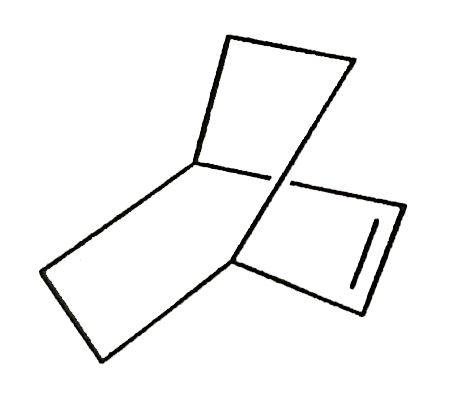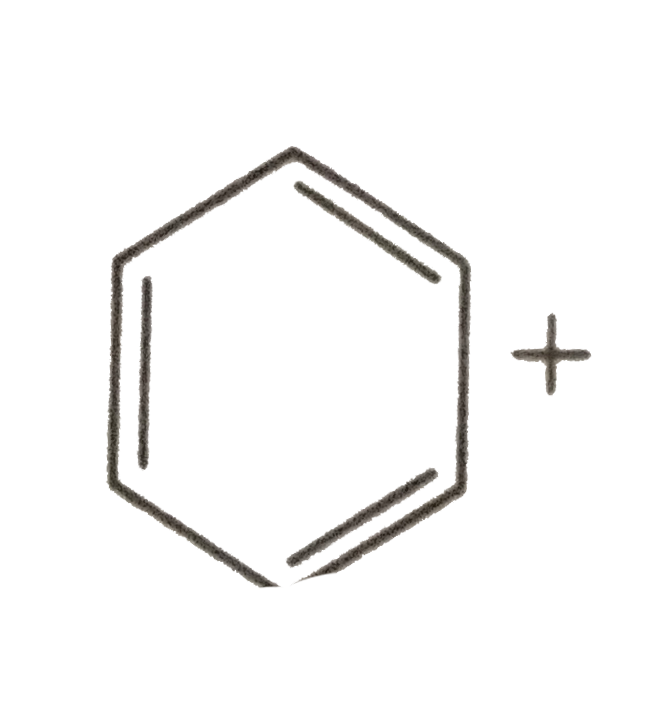A carbonyl compound (P) which gives positive iodoform test, undergoes reaction with MeMgBr followed by dehydration to give an olefin (Q). Ozonolysis of (Q) leads to a dicarbonyl compound (R ) which undergors intramolecular aldol reaction to give predominantly (S).
P1.MeMgBr−−−−−−−→2.H+,H2O3.H2SO4,ΔQ1.O3−−−−−→2.Zn,H2OR1.OH−−−−−→2.ΔS
The structure of products (Q) and (R ), respectively, are:
_E01_667_O01.png)
_E01_667_O02.png)
_E01_667_O03.png)
_E01_667_O04.png)
The correct Answer is:A
To solve the problem step by step, we need to identify the structures of the compounds P, Q, R, and S based on the given reactions and tests.
Step 1: Identify Compound P
- Given Information: Compound P is a carbonyl compound that gives a positive iodoform test.
- Analysis: The iodoform test is positive for compounds that have a methyl ketone (a carbonyl group adjacent to a CH3 group) or ethanol. Therefore, P must be a methyl ketone.
- Structure of P: The simplest methyl ketone is acetone (CH3COCH3).
Step 2: Reaction of P with MeMgBr
- Reaction: P (acetone) reacts with methyl magnesium bromide (MeMgBr), which is a Grignard reagent.
- Mechanism: The Grignard reagent adds to the carbonyl carbon of acetone, forming a tertiary alcohol after hydrolysis.
- Product Q: The product after the reaction and subsequent dehydration (removal of water) will be an alkene. In this case, the product will be 2-methylpropene (isobutylene).
Step 3: Ozonolysis of Q
- Reaction: Q (2-methylpropene) undergoes ozonolysis, which cleaves the double bond and forms carbonyl compounds.
- Product R: The ozonolysis of 2-methylpropene will yield two carbonyl compounds: acetaldehyde (CH3CHO) and acetone (CH3COCH3). However, since we are looking for a dicarbonyl compound, we can consider the product to be 3-oxobutan-2-one (which has two carbonyl groups).
Step 4: Intramolecular Aldol Reaction of R
- Reaction: The dicarbonyl compound R (3-oxobutan-2-one) undergoes an intramolecular aldol reaction.
- Mechanism: In this reaction, one of the carbonyl groups acts as an electrophile, while the adjacent carbon with an alpha hydrogen acts as a nucleophile, leading to the formation of a cyclic compound.
- Product S: The predominant product S from this reaction will be 2,5-dimethyl-2,5-dihydro-3-furanone.
Summary of Products
- P: Acetone (CH3COCH3)
- Q: 2-methylpropene (isobutylene)
- R: 3-oxobutan-2-one (dicarbonyl compound)
- S: 2,5-dimethyl-2,5-dihydro-3-furanone
Final Answer
The structures of products (Q) and (R) are:
- Q: 2-methylpropene (isobutylene)
- R: 3-oxobutan-2-one
- Given Information: Compound P is a carbonyl compound that gives a positive iodoform test.
- Analysis: The iodoform test is positive for compounds that have a methyl ketone (a carbonyl group adjacent to a CH3 group) or ethanol. Therefore, P must be a methyl ketone.
- Structure of P: The simplest methyl ketone is acetone (CH3COCH3).
- Reaction: P (acetone) reacts with methyl magnesium bromide (MeMgBr), which is a Grignard reagent.
- Mechanism: The Grignard reagent adds to the carbonyl carbon of acetone, forming a tertiary alcohol after hydrolysis.
- Product Q: The product after the reaction and subsequent dehydration (removal of water) will be an alkene. In this case, the product will be 2-methylpropene (isobutylene).
- Reaction: Q (2-methylpropene) undergoes ozonolysis, which cleaves the double bond and forms carbonyl compounds.
- Product R: The ozonolysis of 2-methylpropene will yield two carbonyl compounds: acetaldehyde (CH3CHO) and acetone (CH3COCH3). However, since we are looking for a dicarbonyl compound, we can consider the product to be 3-oxobutan-2-one (which has two carbonyl groups).
- Reaction: The dicarbonyl compound R (3-oxobutan-2-one) undergoes an intramolecular aldol reaction.
- Mechanism: In this reaction, one of the carbonyl groups acts as an electrophile, while the adjacent carbon with an alpha hydrogen acts as a nucleophile, leading to the formation of a cyclic compound.
- Product S: The predominant product S from this reaction will be 2,5-dimethyl-2,5-dihydro-3-furanone.
- P: Acetone (CH3COCH3)
- Q: 2-methylpropene (isobutylene)
- R: 3-oxobutan-2-one (dicarbonyl compound)
- S: 2,5-dimethyl-2,5-dihydro-3-furanone
The structures of products (Q) and (R) are:
- Q: 2-methylpropene (isobutylene)
- R: 3-oxobutan-2-one
Topper's Solved these Questions
- ALKENE, ALKANE & ALKYNE BOOK - ALLENCHAPTER - ALKENE, ALKANE & ALKYNE EXERCISE - EXCERSISE-1
25 Videos
- ALKENE, ALKANE & ALKYNE BOOK - ALLENCHAPTER - ALKENE, ALKANE & ALKYNE EXERCISE - EXCERSISE-2
20 Videos
- ALKENE, ALKANE & ALKYNE BOOK - ALLENCHAPTER - ALKENE, ALKANE & ALKYNE EXERCISE - EXERCISE-5[A]
68 Videos
- AIIMS 2019BOOK - ALLENCHAPTER - AIIMS 2019EXERCISE - CHEMISTRY
40 Videos
- ALKYL AND ARYL HALIDEBOOK - ALLENCHAPTER - ALKYL AND ARYL HALIDEEXERCISE - EXERCISE-05 (B)
35 Videos
Similar Questions
A carbonyl compound (P) which gives positive iodoform test, undergoes reaction with MeMgBr followed by dehydration to give an olefin (Q). Ozonolysis of (Q) leads to a dicarbonyl compound (R ) which undergors intramolecular aldol reaction to give predominantly (S).
P1.MeMgBr−−−−−−−→2.H+,H2O3.H2SO4,ΔQ1.O3−−−−−→2.Zn,H2OR1.OH−−−−−→2.ΔS
The structure of product (S) is:
View SolutionA carbonyl compound (P) which gives positive iodoform test, undergoes reaction with MeMgBr followed by dehydration to give an olefin (Q). Ozonolysis of (Q) leads to a dicarbonyl compound (R ) which undergors intramolecular aldol reaction to give predominantly (S).
P1.MeMgBr−−−−−−−→2.H+,H2O3.H2SO4,ΔQ1.O3−−−−−→2.Zn,H2OR1.OH−−−−−→2.ΔS
The structure of product (S) is:
View Solution (i)O3−−−−−−−−→(ii)Zn−H2O¯:OH−−→Δ NO. of aldol condensation product.
(i)O3−−−−−−−−→(ii)Zn−H2O¯:OH−−→Δ NO. of aldol condensation product.
View SolutionBut-2-ene 1.O3−−−−−−−→2.Zn,H2OPOHӨ−−−−−→ΔQPd/C−−−−−→H2R
R is :
View Solution(CH3)2CONaCN−−−→HCI(A)H+3O−−→Δ(B)
In the above sequence of reactions, (A) and (B) are :
View SolutionC6H15O6(P)O3−−−−→Zn,H2OC4H8O4(Q)Molish−−−→reagent Violet colour ring
Structure of P connote be :
View SolutionH−C≡C−HHgSO4−−−−−−→H2SO4dil.NaOH−−−−−→Δ−−→P. The final product P is
View Solution +Cl−CH2CH2CH3AlCl3−−→P(i)O2/Δ−−−−−−−−→(ii)H2OQ+ Phenol
+Cl−CH2CH2CH3AlCl3−−→P(i)O2/Δ−−−−−−−−→(ii)H2OQ+ Phenol
The major products P and Q are :
View SolutionBenzene +Cl−CH2CH2CH3AlCl3−−→P(i)O2/Δ−−−−−−−−→(ii)H2OQ+
Phenol The major products P and Q are :
View SolutionC2H2Hg(OH)21%−−−−−−−−−−→H2SO4A[O]−−→B, B is :
View Solution
